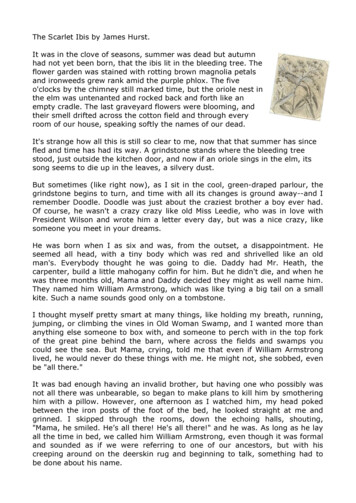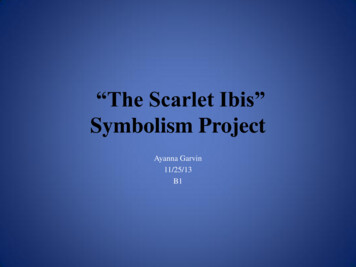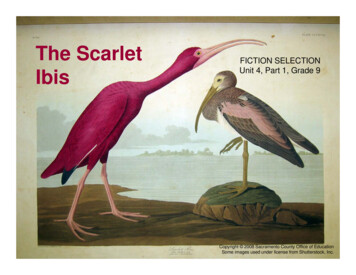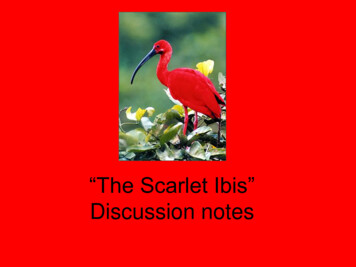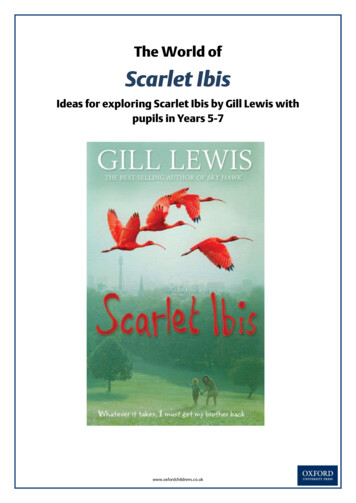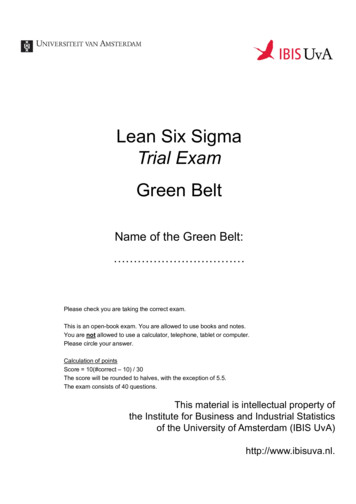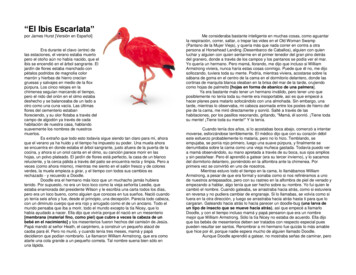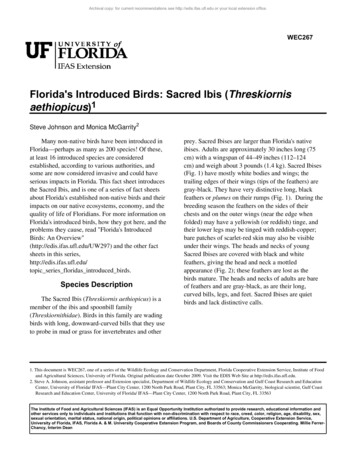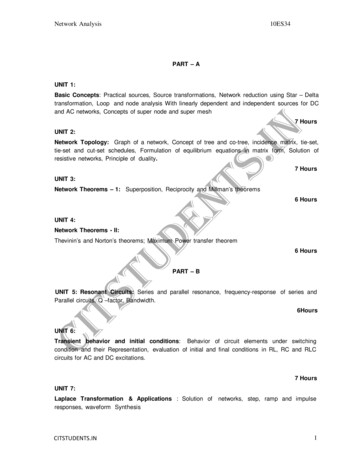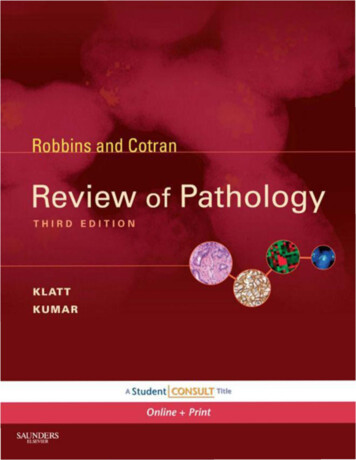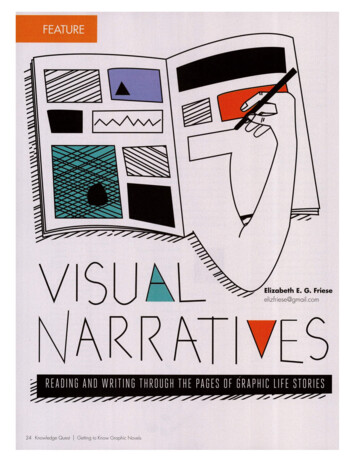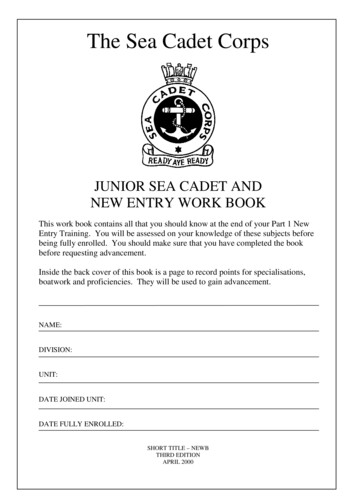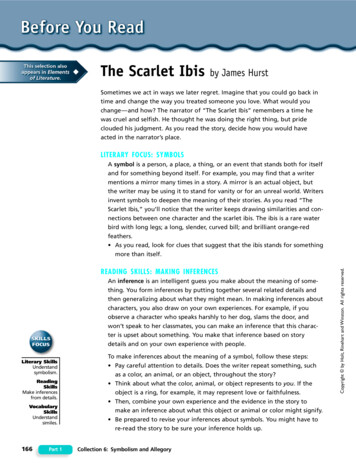
Transcription
The Scarlet Ibisby James HurstSometimes we act in ways we later regret. Imagine that you could go back intime and change the way you treated someone you love. What would youchange and how? The narrator of “The Scarlet Ibis” remembers a time hewas cruel and selfish. He thought he was doing the right thing, but prideclouded his judgment. As you read the story, decide how you would haveacted in the narrator’s place.LITERARY FOCUS: SYMBOLSREADING SKILLS: MAKING INFERENCESAn inference is an intelligent guess you make about the meaning of something. You form inferences by putting together several related details andthen generalizing about what they might mean. In making inferences aboutcharacters, you also draw on your own experiences. For example, if youobserve a character who speaks harshly to her dog, slams the door, andwon’t speak to her classmates, you can make an inference that this character is upset about something. You make that inference based on storydetails and on your own experience with people.Literary SkillsUnderstandsymbolism.ReadingSkillsMake inferencesfrom details.VocabularySkillsUnderstandsimiles.166Part 1To make inferences about the meaning of a symbol, follow these steps: Pay careful attention to details. Does the writer repeat something, suchas a color, an animal, or an object, throughout the story? Think about what the color, animal, or object represents to you. If theobject is a ring, for example, it may represent love or faithfulness. Then, combine your own experience and the evidence in the story tomake an inference about what this object or animal or color might signify. Be prepared to revise your inferences about symbols. You might have tore-read the story to be sure your inference holds up.Collection 6: Symbolism and AllegoryCopyright by Holt, Rinehart and Winston. All rights reserved.A symbol is a person, a place, a thing, or an event that stands both for itselfand for something beyond itself. For example, you may find that a writermentions a mirror many times in a story. A mirror is an actual object, butthe writer may be using it to stand for vanity or for an unreal world. Writersinvent symbols to deepen the meaning of their stories. As you read “TheScarlet Ibis,” you’ll notice that the writer keeps drawing similarities and connections between one character and the scarlet ibis. The ibis is a rare waterbird with long legs; a long, slender, curved bill; and brilliant orange-redfeathers. As you read, look for clues that suggest that the ibis stands for somethingmore than itself.
PREVIEW SELECTION VOCABULARYThe following words appear in the story you’re about to read. You maywant to become familiar with them before you begin reading.sullenly (sul n·l ) adv.: resentfully; gloomily.Sullenly, the narrator took Doodle with him, allthe while resenting the task.imminent (im ·n nt) adj.: near; about tohappen.When thunder boomed and the sky darkened,they could tell the storm was imminent.iridescent (ir i·des nt) adj.: rainbowlike; displaying a shifting range of colors.The bird’s wings glowed with iridescent color.serene (s ·r n ) adj.: peaceful; calm.Copyright by Holt, Rinehart and Winston. All rights reserved.The serene lake was as smooth and calm as amirror.infallibility (in·fal ·bil ·t ) n.: inability to makea mistake.Because of his belief in his infallibility, the narrator never doubted the success of his project.blighted (bl t id) v. used as adj.: suffering fromconditions that destroy or prevent growth.The blighted fields would never produce anycorn or cotton.doggedness (dôg id·nis) n.: stubbornness;persistence.Because of his doggedness, Doodle did learn towalk.reiterated (r ·it ·r†t id) v.: repeated.Several times, the narrator reiterated his desireto teach Doodle to swim.precariously (pri·ker · s·l ) adv.: unsteadily;insecurely.Doodle balanced precariously on his thin legs.mar (mär) v.: damage; spoil.The storm could mar the cotton and other crops,causing the loss of acres of profits.FIGURATIVE LANGUAGEFigurative language helps you see familiar things in new ways. The simplesttype of figurative language, the simile, uses comparisons to create fresh,new meaning. A simile is a comparison between two dissimilar things linkedby a word such as like, as, or resembles. For example:The storm was as fierce as an angry lion.In this simile, a storm is compared to a lion. Comparing a fierce storm to anangry lion helps readers see how violent and dangerous the storm was.As you read “The Scarlet Ibis,” look for other similes. Figure out what isbeing compared. Ask yourself: “What does this simile help me see? Howdoes it help me understand the story more fully?”The Scarlet Ibis167
The Scarlet IbisJames Hurst Frank Lane Picture Agency/CORBIS.It was in the clove of seasons, summer was dead but autumnhad not yet been born, that the ibis lit in the bleeding tree. TheA clove (kl v) is a division orsplit of some kind. Duringwhat time of year does thisstory take place?flower garden was stained with rotting brown magnolia petals,and ironweeds grew rank1 amid the purple phlox. The fiveo’clocks by the chimney still marked time, but the oriole nest inempty cradle. The last graveyard flowers were blooming, andtheir smell drifted across the cotton field and through everyroom of our house, speaking softly the names of our dead.It’s strange that all this is still so clear to me, now that that10summer has long since fled and time has had its way. A grindRe-read the narrator’sdescription of the garden(lines 1-9). Underline thewords and phrases that bringto mind death or dying.stone stands where the bleeding tree stood, just outside thekitchen door, and now if an oriole sings in the elm, its songseems to die up in the leaves, a silvery dust. The flower garden isprim, the house a gleaming white, and the pale fence across theyard stands straight and spruce. But sometimes (like right now),Notesas I sit in the cool, green-draped parlor, the grindstone begins toturn, and time with all its changes is ground away—and Iremember Doodle.1.rank (ra«k) adj.: thick and wild. Rank also means “smelly.”“The Scarlet Ibis” by James R. Hurst from The Atlantic Monthly, July 1960. Copyright 1960 by The AtlanticMonthly. Reprinted by permission of the author.168Part 1Collection 6: Symbolism and AllegoryCopyright by Holt, Rinehart and Winston. All rights reserved.the elm was untenanted and rocked back and forth like an
Doodle was just about the craziest brother a boy ever had.20Of course, he wasn’t a crazy crazy like old Miss Leedie, who wasin love with President Wilson and wrote him a letter every day,but was a nice crazy, like someone you meet in your dreams. Hewas born when I was six and was, from the outset, a disappoint-Re-read lines 20-23.Underline the detail that tellsyou that the story takesplace in the past.ment. He seemed all head, with a tiny body which was red andshriveled like an old man’s. Everybody thought he was going todie—everybody except Aunt Nicey, who had delivered him. Shesaid he would live because he was born in a caul2 and cauls weremade from Jesus’ nightgown. Daddy had Mr. Heath, the carpen30ter, build a little mahogany coffin for him. But he didn’t die, andwhen he was three months old, Mama and Daddy decided theyIn lines 32-33, the narratorcompares his brother’s givenname to a “big tail on asmall kite.” What does thissimile tell you about the narrator’s opinion of his brother’s name?might as well name him. They named him William Armstrong,which was like tying a big tail on a small kite. Such a namesounds good only on a tombstone.I thought myself pretty smart at many things, like holdingmy breath, running, jumping, or climbing the vines in OldWoman Swamp, and I wanted more than anything else someoneto race to Horsehead Landing, someone to box with, and someone to perch with in the top fork of the great pine behind theCopyright by Holt, Rinehart and Winston. All rights reserved.40barn, where across the fields and swamps you could see the sea.I wanted a brother. But Mama, crying, told me that even ifWilliam Armstrong lived, he would never do these things withme. He might not, she sobbed, even be “all there.” He might, aslong as he lived, lie on the rubber sheet in the center of the bedin the front bedroom where the white marquisette3 curtains billowed out in the afternoon sea breeze, rustling like palmettofronds.4It was bad enough having an invalid brother, but havingone who possibly was not all there was unbearable, so I began to50make plans to kill him by smothering him with a pillow.2.3.4.caul (kôl) n.: membrane (thin, skinlike material) that sometimescovers a baby’s head at birth.marquisette (mär ki·zet ) adj.: made of a thin, netlike fabric.palmetto fronds: fanlike leaves of a palm tree.Re-read lines 35-41. Whatdoes the narrator want?Underline what you find out.The Scarlet Ibis169
However, one afternoon as I watched him, my head pokedbetween the iron posts of the foot of the bed, he looked straightat me and grinned. I skipped through the rooms, down theWhy is it so important to thenarrator that his brother is“all there” (lines 54-55)?echoing halls, shouting, “Mama, he smiled. He’s all there! He’sall there!” and he was.When he was two, if you laid him on his stomach, he began totry to move himself, straining terribly. The doctor said that withhis weak heart this strain would probably kill him, but it didn’t.Trembling, he’d push himself up, turning first red, then a soft60purple, and finally collapse back onto the bed like an old wornout doll. I can still see Mama watching him, her hand pressedtight across her mouth, her eyes wide and unblinking. But helearned to crawl (it was his third winter), and we brought himWhat does the description inlines 59-61 tell you aboutDoodle?out of the front bedroom, putting him on the rug before thefireplace. For the first time he became one of us.As long as he lay all the time in bed, we called him WilliamArmstrong, even though it was formal and sounded as if wewere referring to one of our ancestors, but with his creepingaround on the deerskin rug and beginning to talk, something70had to be done about his name. It was I who renamed him.When he crawled, he crawled backward, as if he were in reverseand couldn’t change gears. If you called him, he’d turn aroundas if he were going in the other direction, then he’d back rightup to you to be picked up. Crawling backward made him looklike a doodlebug5 so I began to call him Doodle, and in timeeven Mama and Daddy thought it was a better name thanWilliam Armstrong. Only Aunt Nicey disagreed. She said caulbabies should be treated with special respect since they mightturn out to be saints. Renaming my brother was perhaps the80kindest thing I ever did for him, because nobody expects muchfrom someone called Doodle.5.170Part 1doodlebug (dºd l·bug ) n.: larva of a type of insect that movesbackward.Collection 6: Symbolism and AllegoryCopyright by Holt, Rinehart and Winston. All rights reserved.Pause at line 79. Why doesn’tAunt Nicey like Doodle’snickname?
Although Doodle learned to crawl, he showed no signs ofwalking, but he wasn’t idle. He talked so much that we all quitlistening to what he said. It was about this time that Daddy builthim a go-cart, and I had to pull him around. At first I justparaded him up and down the piazza,6 but then he started cry-What does the narratortransport Doodle in (lines82-90)? Underline the sentence where you find out.ing to be taken out into the yard and it ended up by my havingto lug him wherever I went. If I so much as picked up my cap,he’d start crying to go with me, and Mama would call from90wherever she was, “Take Doodle with you.”He was a burden in many ways. The doctor had said that heRe-read lines 91-101. In yourown words, describe the narrator and his brother as theymight look to an observer.mustn’t get too excited, too hot, too cold, or too tired and thathe must always be treated gently. A long list of don’ts went withhim, all of which I ignored once we got out of the house. To discourage his coming with me, I’d run with him across the ends ofthe cotton rows and careen him around corners on two wheels.Sometimes I accidentally turned him over, but he never toldMama. His skin was very sensitive, and he had to wear a bigstraw hat whenever he went out. When the going got rough and100he had to cling to the sides of the go-cart, the hat slipped all theway down over his ears. He was a sight. Finally, I could see I wasCopyright by Holt, Rinehart and Winston. All rights reserved.licked. Doodle was my brother, and he was going to cling to meforever, no matter what I did, so I dragged him across the burning cotton field to share with him the only beauty I knew, OldWoman Swamp. I pulled the go-cart through the sawtooth fern,down into the green dimness where the palmetto fronds whispered by the stream. I lifted him out and set him down in thesoft rubber grass beside a tall pine. His eyes were round withwonder as he gazed about him, and his little hands began to110stroke the rubber grass. Then he began to cry.“For heaven’s sake, what’s the matter?” I asked, annoyed.“It’s so pretty,” he said. “So pretty, pretty, pretty.”After that day Doodle and I often went down into OldWoman Swamp. I would gather wildflowers, wild violets,6.Re-read lines 108-112, andcircle the details that helpyou infer Doodle’s charactertraits. What are they?piazza (p ·az ) n.: large covered porch.The Scarlet Ibis171
honeysuckle, yellow jasmine, snakeflowers, and waterlilies, andwith wire grass we’d weave them into necklaces and crowns.Re-read the long sentence inlines 122-125. What is thenarrator saying about therelationship between loveand cruelty?We’d bedeck ourselves with our handiwork and loll about thusbeautified, beyond the touch of the everyday world. Then whenthe slanted rays of the sun burned orange in the tops of the120pines, we’d drop our jewels into the stream and watch them floataway toward the sea.There is within me (and with sadness I have watched it inothers) a knot of cruelty borne by the stream of love, much asour blood sometimes bears the seed of our destruction, and attimes I was mean to Doodle. One day I took him up to the barnloft and showed him his casket, telling him how we all hadsullenly (sul n·l ) adv.:resentfully; gloomily.believed he would die. It was covered with a film of Paris green7sprinkled to kill the rats, and screech owls had built a nestinside it.Doodle studied the mahogany box for a long time, then130Pause at line 144. Why do youthink the narrator showsDoodle the coffin? Whatmight this event foreshadow?said, “It’s not mine.”“It is,” I said. “And before I’ll help you down from the loft,you’re going to have to touch it.”“I won’t touch it,” he said sullenly.made as if I were going down.Doodle was frightened of being left. “Don’t go leave me,Brother,” he cried, and he leaned toward the coffin. His hand,trembling, reached out, and when he touched the casket, he140screamed. A screech owl flapped out of the box into our faces,scaring us and covering us with Paris green. Doodle was paralyzed, so I put him on my shoulder and carried him down theladder, and even when we were outside in the bright sunshine,he clung to me, crying, “Don’t leave me. Don’t leave me.”When Doodle was five years old, I was embarrassed at having abrother of that age who couldn’t walk, so I set out to teach him.7.172Part 1Paris green n.: poisonous green powder used to kill insects.Collection 6: Symbolism and AllegoryCopyright by Holt, Rinehart and Winston. All rights reserved.“Then I’ll leave you here by yourself,” I threatened, and
Notes PhotoDisc, Inc./Getty Images.We were down in Old Woman Swamp and it was spring and theCopyright by Holt, Rinehart and Winston. All rights reserved.sick-sweet smell of bay flowers hung everywhere like a mournfulsong. “I’m going to teach you to walk, Doodle,” I said.150He was sitting comfortably on the soft grass, leaning backRe-read lines 147-149.Underline the simile, andexplain what two things arebeing compared.against the pine. “Why?” he asked.I hadn’t expected such an answer. “So I won’t have to haulyou around all the time.”“I can’t walk, Brother,” he said.“Who says so?” I demanded.“Mama, the doctor—everybody.”“Oh, you can walk,” I said, and I took him by the arms andstood him up. He collapsed onto the grass like a half-emptyflour sack. It was as if he had no bones in his little legs.160“Don’t hurt me, Brother,” he warned.“Shut up. I’m not going to hurt you. I’m going to teach youto walk.” I heaved him up again, and again he collapsed.The Scarlet Ibis173
This time he did not lift his face up out of the rubber grass.“I just can’t do it. Let’s make honeysuckle wreaths.”“Oh yes you can, Doodle,” I said. “All you got to do is try.Pause at line 171. Underlinethe two statements the narrator makes about pride. Puthis statements in your ownwords.Now come on,” and I hauled him up once more.It seemed so hopeless from the beginning that it’s a miracleI didn’t give up. But all of us must have something or someoneto be proud of, and Doodle had become mine. I did not know170then that pride is a wonderful, terrible thing, a seed that bearstwo vines, life and death. Every day that summer we went to thepine beside the stream of Old Woman Swamp, and I put him onhis feet at least a hundred times each afternoon. Occasionally Itoo became discouraged because it didn’t seem as if he was trying, and I would say, “Doodle, don’t you want to learn to walk?”He’d nod his head, and I’d say, “Well, if you don’t keep trying, you’ll never learn.” Then I’d paint for him a picture of us asold men, white-haired, him with a long white beard and me stillpulling him around in the go-cart. This never failed to makeUnderline the simile in lines184-186. What do you thinkthe narrator means?180him try again.Finally, one day, after many weeks of practicing, he stoodalone for a few seconds. When he fell, I grabbed him in my armsringing bell. Now we knew it could be done. Hope no longer hidin the dark palmetto thicket but perched like a cardinal in thelacy toothbrush tree, brilliantly visible. “Yes, yes,” I cried, and hecried it too, and the grass beneath us was soft and the smell ofthe swamp was sweet.With success so imminent, we decided not to tell anyone190until he could actually walk. Each day, barring rain, we sneakedinto Old Woman Swamp, and by cotton-picking time Doodlewas ready to show what he could do. He still wasn’t able to walkfar, but we could wait no longer. Keeping a nice secret is veryhard to do, like holding your breath. We chose to reveal all onOctober eighth, Doodle’s sixth birthday, and for weeks ahead weimminent (im ·n nt) adj.:near; about to happen.174Part 1mooned around the house, promising everybody a mostCollection 6: Symbolism and AllegoryCopyright by Holt, Rinehart and Winston. All rights reserved.and hugged him, our laughter pealing through the swamp like a
spectacular surprise. Aunt Nicey said that, after so much talk, ifwe produced anything less tremendous than the Resurrection,8she was going to be disappointed.At breakfast on our chosen day, when Mama, Daddy, and200Aunt Nicey were in the dining room, I brought Doodle to theRe-read lines 215-218. Is thenarrator describing pridethat brings something wonderful or something terrible?door in the go-cart just as usual and had them turn their backs,making them cross their hearts and hope to die if they peeked. Ihelped Doodle up, and when he was standing alone I let themlook. There wasn’t a sound as Doodle walked slowly across theroom and sat down at his place at the table. Then Mama beganto cry and ran over to him, hugging him and kissing him. Daddyhugged him too, so I went to Aunt Nicey, who was thanks-praying in the doorway, and began to waltz her around. We danced210together quite well until she came down on my big toe with herbrogans,9 hurting me so badly I thought I was crippled for life.Doodle told them it
Scarlet Ibis,” you’ll notice that the writer keeps drawing similarities and con-nections between one character and the scarlet ibis. The ibis is a rare water bird with long legs; a long, slender, curved bill; and brilliant orange-red feathers. As you read, look for clues that suggest that the
